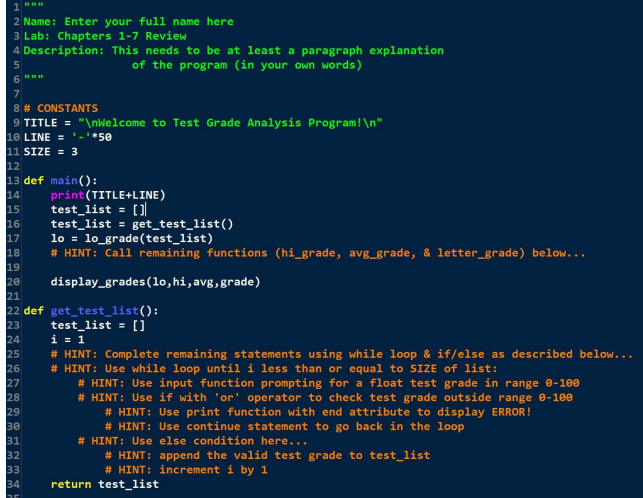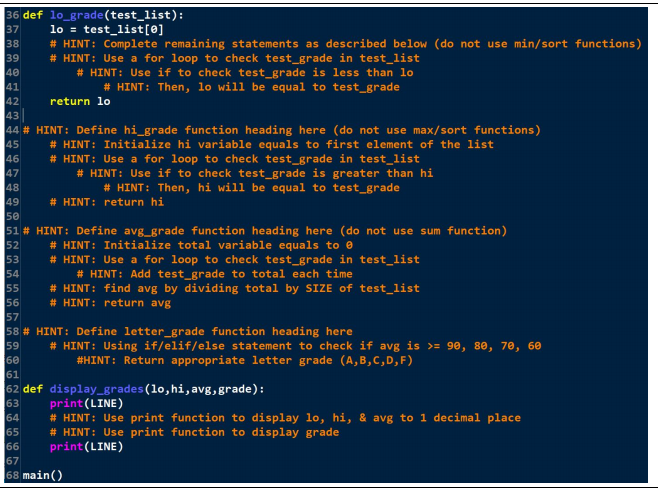PYTHON PROGRAM a. Write a modular program, that accepts a series of 3 test grades, validates each test grade (to be in the range 0-
PYTHON PROGRAM
a. Write a modular program, that accepts a series of 3 test grades, validates each test grade (to be in the range 0- 100). The program should store the test grades in a list and then determine the following data calling appropriate functions as described in step 4b below (do not use standard functions like min, max, sum, sort, etc.!):
The lowest test grade in the list
The highest test grade in the list
The average of the test grades in the list
Letter grade of the average test grade
b. The program should display the output/results including the lowest, highest, average test grade (all 3 values formatted to 1 decimal place), and the letter grade (NOTE: Other than the data input, your output should look EXACTLY like in the below table showing a few sample runs for you to compare, the items shown after the colon symbol are what you enter as input; those items can vary for each sample run):
b. Below the top comment block, type the actual python code for the problem described in step 3. Make sure to include the functions as described below EXACTLY! (Refer to the sample code screenshot below with function calls and definition examples and HINTS):
a. main() This should be the first and foremost function called and defined (Refer to line #s 68 and 13 - 20 in the below sample code screenshot on how this function is called, and HINTS for how other functions should be called in the main function definition)
b. get_test_list() This should be a value returning function called by main() function, that accepts no arguments. This function asks the user to enter a test grade, validates it (to be in the range 0-100), stores in a list if valid and returns the list back to the main function (Refer to line #s 16 and 22 - 34 HINTS in the below screenshot)
c. lo_grade() This should be a value returning function called by main function, that accepts one list argument. This function should find and return the lowest of the 3 test grades in the list. Remember not to use the min, sort, or any other standard functions available. (Refer to line #s 17 and 36 42 HINTS in the below screenshot)
d. hi_grade() This should be a value returning function called by main function, that accepts one list argument. This function should find and return the highest of the 3 test grades in the list. Remember not to use the max, sort, or any other standard functions available (Refer to line #s 18 and 44 - 49 HINTS in the below screenshot)
e. avg_grade() This should be a value returning function called by main function, that accepts one list argument. This function should find and return the average of the 3 test grades in the list. Remember not to use the sum or any other standard functions available (Refer to line #s 18 and 51 - 56 HINTS in the below screenshot) f. letter_grade() Page 3 of 4 Page 3 of 4 This should be a value returning function called by main function, that accepts one argument avg test grade. This function should find and return the letter grade of the average (Refer to line #s 18 and 58 - 60 HINTS in the below screenshot)
g. display_grades() This should be a void function called by main function that accepts four arguments - lowest test grade, highest test grade, the average test grade (all 3 values formatted up to 1 decimal place), and the letter grade of avg, and displays them (Refer to line #s 20 and 62 - 66 HINTS in the below screenshot) Make sure to include the following in your program as well:
i. Define appropriate/descriptive CONSTANTS (Refer to line #s 8 11 in the below screenshot)
ii. Use appropriate/descriptive variable_names (Refer to line #s 15 17, 23-24, and 37 in the below screenshot)
iii. Have enough documentation for understandability of your program by including a comment block at the beginning of the program (Refer to line #s 1 6 in the below screenshot) and prior to each function describing in your own words the purpose of each function by explaining the logic of loop, if, and other python functions used (refer to Textbook/Instructor EXAMPLE PROGRAMS listed in Canvas Modules)
iv. Have proper indentation and line spacing for readability of your program (refer to Textbook/Instructor EXAMPLE PROGRAMS listed in Canvas Modules)
The sample should be like below but filled:


Step by Step Solution
There are 3 Steps involved in it
Step: 1

See step-by-step solutions with expert insights and AI powered tools for academic success
Step: 2

Step: 3

Ace Your Homework with AI
Get the answers you need in no time with our AI-driven, step-by-step assistance
Get Started


